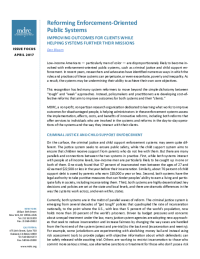Reforming Enforcement-Oriented Public Systems
Improving Outcomes for Clients While Helping Systems Further Their Missions

Low-income Americans — particularly men of color — are disproportionately likely to become involved with enforcement-oriented public systems, such as criminal justice and child support enforcement. In recent years, researchers and advocates have identified numerous ways in which the rules and practices of these systems can perpetuate, or even exacerbate, poverty and inequality. As a result, the systems may be undermining their ability to achieve their own core objectives.
This recognition has led many system reformers to move beyond the simple dichotomy between “tough” and “weak” approaches. Instead, policymakers and practitioners are developing cost-effective reforms that aim to improve outcomes for both systems and their “clients.”
MDRC, a nonprofit, nonpartisan research organization dedicated to learning what works to improve outcomes for disadvantaged people, is helping administrators in these enforcement systems assess the implementation, effects, costs, and benefits of innovative reforms, including both reforms that offer services to individuals who are involved in the systems and reforms in the day-to-day operations of the systems and the way they interact with their clients.
Criminal Justice and Child Support Enforcement
On the surface, the criminal justice and child support enforcement systems may seem quite different. The justice system seeks to ensure public safety, while the child support system aims to ensure that children receive support from parents who do not live with them. But there are many parallels and connections between the two systems in practice. First, while both systems interact with people at all income levels, low-income men are particularly likely to be caught up in one or both of them. One study found that 57 percent of incarcerated men between the ages of 27 and 42 earned $22,500 or less in the year before their incarceration. Similarly, about 70 percent of child support debt is owed by parents who earn $10,000 a year or less. Second, both systems have the legal authority to take punitive measures that can hinder peoples’ ability to earn a living and participate fully in society, including incarcerating them. Third, both systems are highly decentralized: key decisions and policies are set at the state and local levels, and there are dramatic differences in the way the systems work across, and even within, states.
Currently, both systems are in the midst of parallel waves of reform. The criminal justice system is emerging from several decades of “get tough” policies that quadrupled the rate of incarceration nationally, to the point where the U.S., with less than 5 percent of the world’s population, now holds more than 20 percent of the world’s prisoners. Driven by budget pressures and concerns about unequal treatment under the law, many justice system agencies are adopting new approaches that seek to reduce incarceration and increase fairness by changing the way cases are handled from the front end of the system (arrest and pre-trial) to the back end (incarceration and reentry). For example, some jurisdictions are experimenting with abolishing money bail and instead using risk assessment tools to provide judges with objective information about which defendants can be safely released while awaiting trial. Others are working to restrict incarceration to those who commit more serious crimes, use alternative sanctions or treatment for those who don’t pose a risk to public safety, and offer services designed to reduce recidivism among people who are released from jail or prison.
The child support system has become increasingly adept at locating and collecting child support from noncustodial parents who work steadily in the formal economy, usually by withholding money directly from their paychecks. But the system still struggles to deal with noncustodial parents who are chronically unemployed or underemployed and unable to meet their support obligations. These parents may face child support orders that are beyond their means, and the system may respond punitively when they do not pay — by suspending their drivers’ licenses, holding them in contempt of court, or even jailing them. Prompted in part by a Supreme Court decision that required states to provide safeguards to ensure that they do not incarcerate parents who lack the means to pay support, states are experimenting with new ways to respond to noncompliance. For example, some states are working harder to understand nonpaying noncustodial parents’ economic circumstances, ensure that child support orders reflect the parent’s ability to pay, and provide employment services to parents who are out of work.
Testing System Reforms and Services for Clients
MDRC has a long history of conducting research in both the criminal justice and child support systems. Most of MDRC’s past justice and child support projects have tested particular packages of services or supports that were offered to people involved in the systems to help them find jobs or achieve other positive outcomes. The simple fact that the systems funded these services or referred people to them illustrates that state and local officials were adopting a broader vision of how to achieve their core missions. Providing access to services to address clients’ underlying challenges has become part of the standard operating procedures of these systems in many places.
In recent years, MDRC has begun to delve into the inner workings of the systems, studying how they respond to their clients. For example, a Demonstration Field Experiment, funded by the National Institute of Justice, is studying the implementation of a new model designed to change the day-to-day practices of parole officers in their supervision of clients recently released from prison. In the Behavioral Interventions in Child Support Services (BICS) project, funded by the federal Office of Child Support Enforcement (OCSE), a team led by MDRC is working with eight states to develop and test new child support procedures that are informed by principles of behavioral economics.
Newer projects are continuing this trend. MDRC is leading an evaluation of New York City’s pre-trial Supervised Release program, which offers a new alternative for judges who are deciding how to handle cases while defendants are awaiting trial. A key goal is to reduce the number of people who are held in jail because they cannot afford to post bail (up to 45,000 people per year in New York City). Jail is often the first step toward further justice involvement. MDRC is also studying risk-based decision making tools designed to provide courts with reliable and objective data to inform decisions about whether individual defendants can be safely released pre-trial.
In the child support realm, MDRC is leading the Procedural Justice Informed Alternatives to Contempt (PJAC) project, sponsored by OCSE, which is testing new system approaches for cases where the noncustodial parent is not paying support and normal enforcement measures have been ineffective. A key goal is to reduce the number of low-income parents who are held in contempt of court and potentially incarcerated.
In all of these studies, MDRC is assessing how the reforms affect both system goals and the well-being of individual clients. For example, justice-related projects measure whether individuals are incarcerated pretrial and for how long, appearance rates in court hearings, dispositions, and outcomes such as arrests and violent crime. Child support projects measure whether cases are subject to contempt proceedings and other enforcement actions, the time it takes to establish or modify a child support order, child support payment outcomes, as well as employment rates and earnings for noncustodial parents. Ideally, the reforms will improve both system performance and the well-being of clients, achieving a double-benefit for taxpayers and families.
Looking Forward
MDRC hopes to build further evidence on the different approaches described in this brief. It is critical to continue to test the efficacy of individually-focused interventions that aim to address underlying factors that contribute to crime and child support noncompliance — for example, by helping people find steady jobs and learn to control attitudes and thought patterns that lead to self-destructive behavior.
At the same time, it is equally important to study the efficacy of changes in the way enforcement systems respond to their clients. These new processes may help systems achieve their core goals, while also increasing fairness and improving outcomes for clients.






